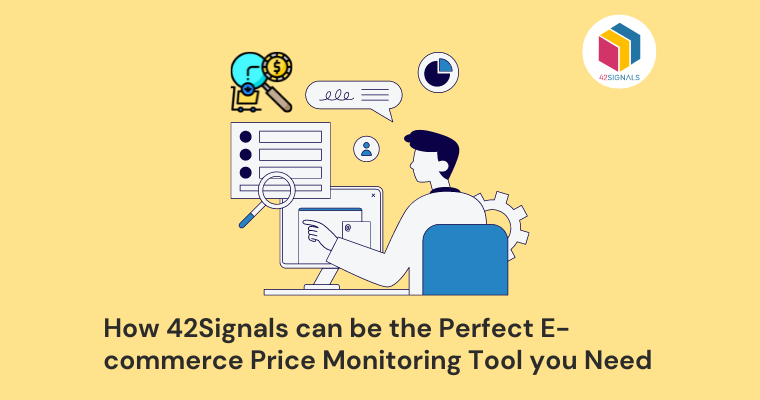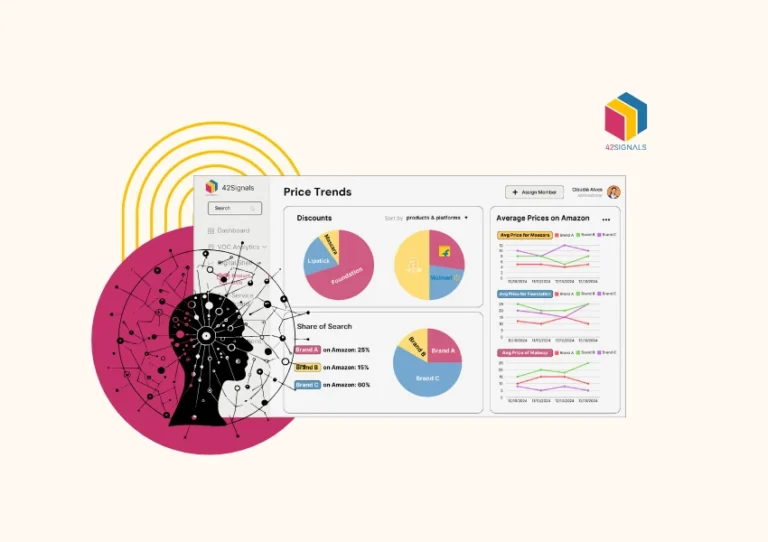What’s the use of an ecommerce price monitoring tool? Such tools help monitor competitors’ prices, enabling retailers to adjust their pricing strategies accordingly and ensuring they offer customers the best deals possible.
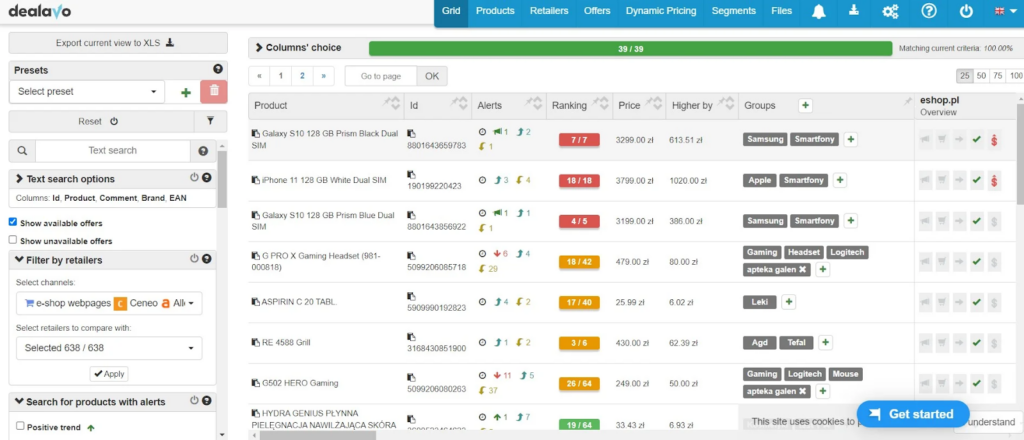
Image Source: Dealavo
However, with so many options available, finding the perfect e-commerce price monitoring tool can be overwhelming. Let’s look at a few ways to choose the best platform suited for your needs.
ECommerce Price Monitoring Tool To Understand Business Needs
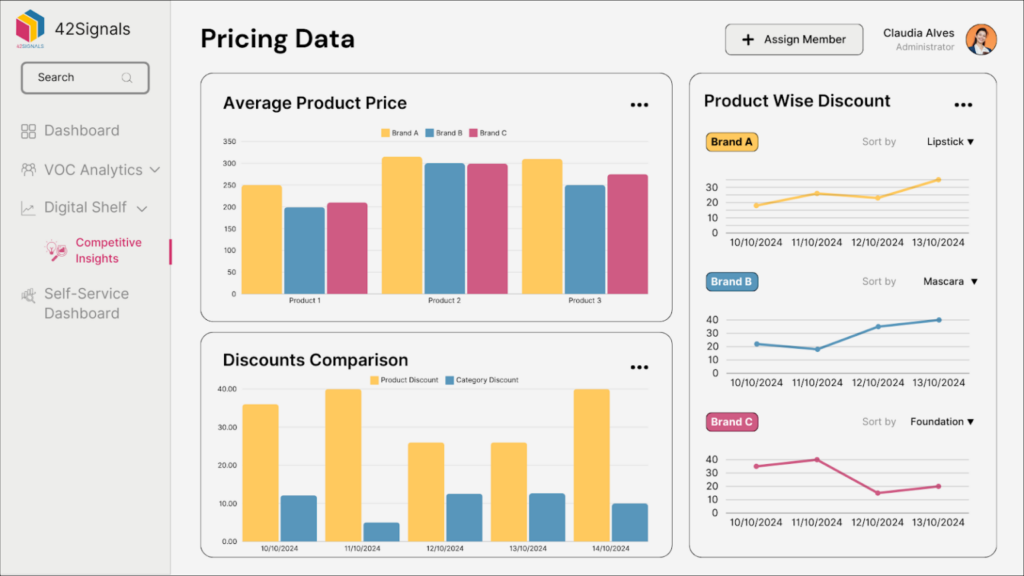
Before diving into the world of price monitoring tools, it’s crucial to understand your business needs.
Consider the following questions for your ecommerce price monitoring tool:
What type of products do you sell? (e.g., electronics, fashion, home goods)
- What specific industry or vertical does your business operate in (e.g., consumer electronics, luxury fashion, sustainable home goods)?
- Are your products physical goods, digital products, or services?
- Do you sell niche or specialty products (e.g., organic skincare, smart home devices, industrial equipment)?
- Are there subcategories or seasonal products we should prioritize (e.g., winter apparel, gaming accessories)?
How many competitor websites do you want to track?
- How many competitor websites/apps do you aim to monitor initially (e.g., 5–10, 50+)?
- Do you already have a list of competitors, or would you like assistance identifying them?
- Should the tool focus on direct competitors (similar products/price ranges) or also include indirect competitors (e.g., substitutes, broader market players)?
- Are there regional or global competitors to prioritize (e.g., tracking local vs. international brands)?
Do you need real-time updates or periodic reports with your ecommerce price monitoring tool?
- Do you require real-time alerts (e.g., for price drops, stock changes, flash sales) or daily/weekly summaries?
- For periodic reports: What cadence works best (daily, weekly, monthly)?
- Should reports include visual dashboards, raw data exports (CSV/Excel), or both?
- Are there specific metrics to highlight (e.g., pricing trends, promotional activity, customer reviews)?
Are you interested in tracking specific product categories or brands?
- Should the tool focus on specific product categories (e.g., smartphones, athleisure wear) or brands (e.g., Apple, Nike)?
- Do you want to track competitor product launches, discontinuations, or stock availability?
- Are you interested in monitoring private-label competitors or emerging brands?
- Should we exclude any irrelevant brands/categories to reduce noise?
Does the tool need to integrate with your existing systems?
- Do you need the tool to integrate with existing platforms (e.g., ERP, CRM, inventory management, BI tools)?
- Are there preferred APIs or formats (e.g., JSON, XML) for data synchronization?
- Does your team require pre-built connectors (e.g., Shopify, Google Analytics, Tableau)?
- Are there security or compliance protocols (e.g., GDPR, encryption) the tool must adhere to?

Image Source: Gelato
Answering these questions will help narrow down your choices and find a solution tailored to your unique requirements.
Key Features to Look For in a Price Monitoring Tool
When evaluating different e-commerce price monitoring tools, consider the following features:
- Accuracy: A reliable tool should provide accurate and up-to-date information about competitors’ prices. Ensure the tool uses advanced algorithms and web scraping techniques to gather data from various sources.
- Customization: Look for a tool that allows you to customize alerts based on specific criteria such as price changes, stock levels, and new product listings.
- Integration: Seamless integration with your current e-commerce platform, inventory management system, or CRM is vital for efficient workflows and data analysis.
- Reporting: Comprehensive reporting capabilities enable you to analyze trends, identify opportunities, and make informed decisions. Opt for a tool that offers visual representations of data, exportable reports, and historical price comparisons.
- User Experience: An intuitive user interface ensures easy navigation and reduces the learning curve for users. Additionally, responsive customer support guarantees assistance when needed.
- Scalability: As your business grows, so too might your pricing needs. Choose a tool capable of scaling alongside your enterprise without compromising performance or accuracy.
- Security: Protect sensitive business information by selecting a tool that adheres to strict security standards and follows ethical practices regarding data collection and storage.
- Pricing: Finally, consider the cost of each tool relative to its value proposition. Balance affordability with functionality to maximize ROI.
42Signals as the Best ECommerce Price Monitoring Tool
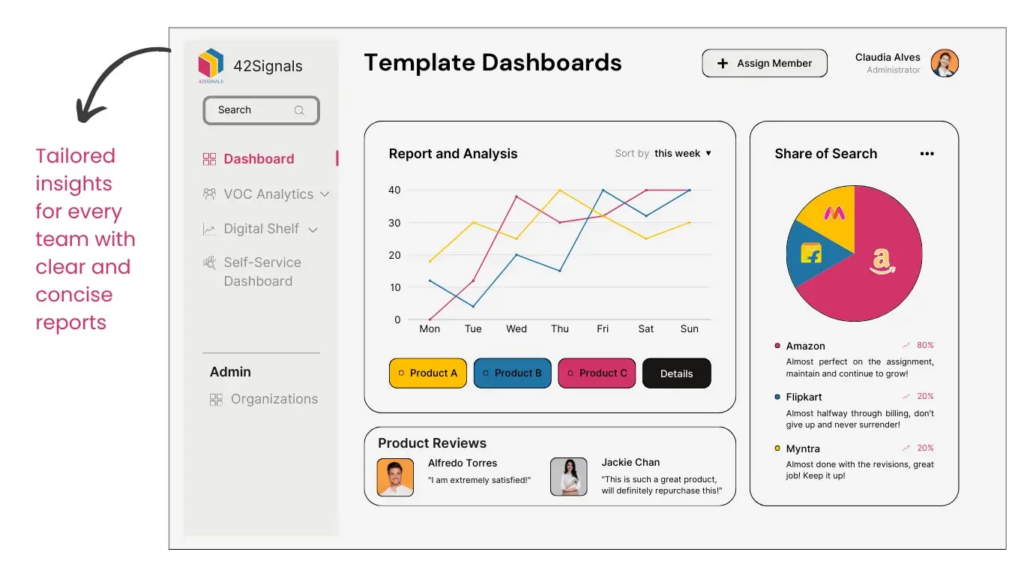
Let’s get into why 42Signals is a frontrunner with its impressive suite of features and unwavering dedication to customer satisfaction. Here are 5 reasons why –
Real-Time Market Intelligence
One of the most notable aspects of 42Signals is its ability to deliver real-time market data, empowering businesses to remain nimble amidst constant fluctuations in the e-commerce ecosystem via digital shelf analytics.
Its sophisticated algorithms continuously scan e-commerce marketplaces, gathering relevant information about competitor pricing, product availability, and consumer sentiment. By furnishing stakeholders with instantaneous insights, 42Signals enables prompt decision-making, ensuring that companies never fall behind the curve.
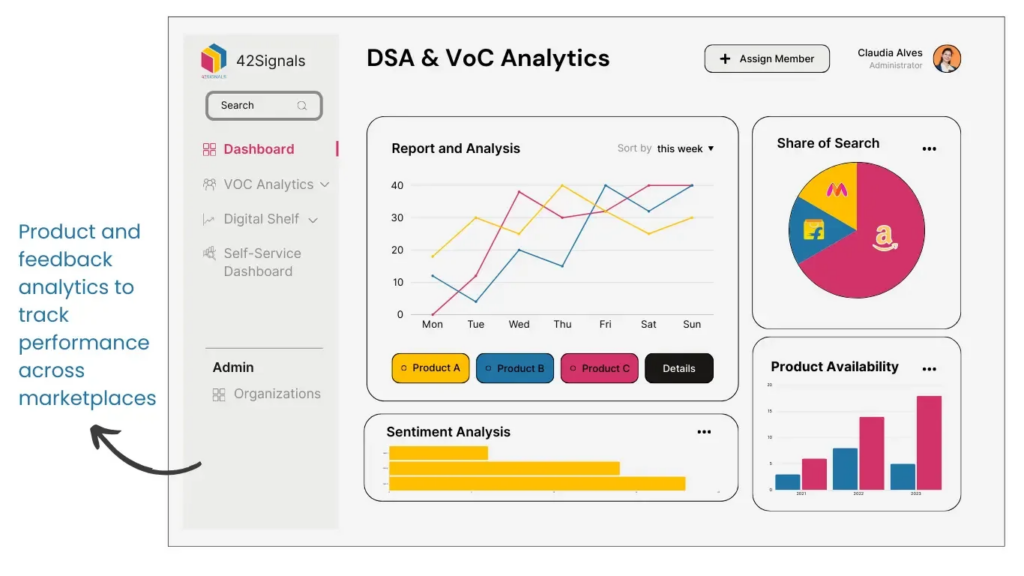
Advanced Anti-Bot Measures
Navigating through anti-scraping technologies employed by competitors can often prove challenging for price monitoring tools. However, 42Signals has risen above this obstacle by employing adaptive data collection methods designed to circumvent even the most stringent countermeasures.
Businesses utilizing 42Signals benefit from reliable and consistent market insights that help identify key selling points, features, and benefits of listed products.
Accessible User Interface
Data analysis can sometimes feel daunting, especially for those lacking technical expertise. Recognizing this challenge, 42Signals has crafted a self-service dashboard interface that emphasizes simplicity and intuitiveness.
Users unfamiliar with complex analytic tools will appreciate the streamlined design, which renders intricate datasets readily digestible. Moreover, the platform’s flexibility accommodates both basic and advanced functionalities, catering to diverse user requirements while preserving a uniformly positive user experience.
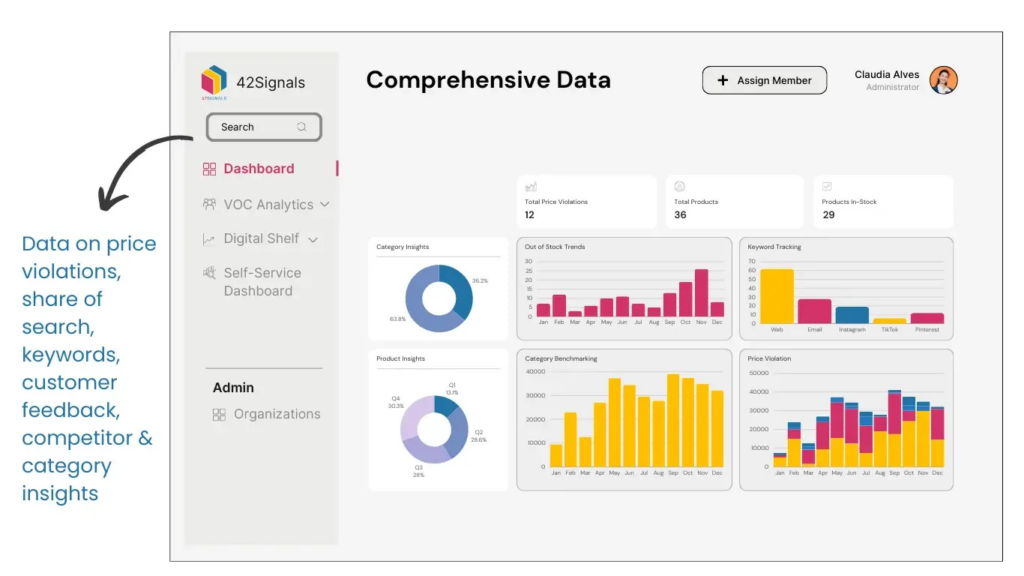
Unmatched Versatility
Whether operating a burgeoning startup or managing an established enterprise, businesses require price monitoring tools that scale effortlessly with their growing demands. 42Signals addresses this necessity by offering versatile custom service plans tailored to accommodate varying organizational scales.
Furthermore, its compatibility extends beyond mere pricing analyses; the platform encompasses features dedicated to MAP violation detection, and customer review aggregation, the share of search, and seller intelligence, solidifying its status as a holistic e-commerce solution.
Committed Customer Support
A company’s reputation hinges upon its capacity to address client concerns and queries effectively. In this regard, 42Signals provides attentive and proactive customer support.
Rather than relegating clients to automated responses or labyrinthine phone trees, representatives engage directly with users, fostering meaningful dialogues aimed at resolving pressing issues.
With advanced data scraping capabilities, 42Signals provides custom requirements that exactly suit the user’s needs. From providing the right data from websites – bestsellers, price fluctuations, product attributes, product characteristics changes and frequency, to much more. With decade-long expertise, the team answers all requirements.
What Makes 42Signals the Best Choice for your ECommerce Price Monitoring Tool?
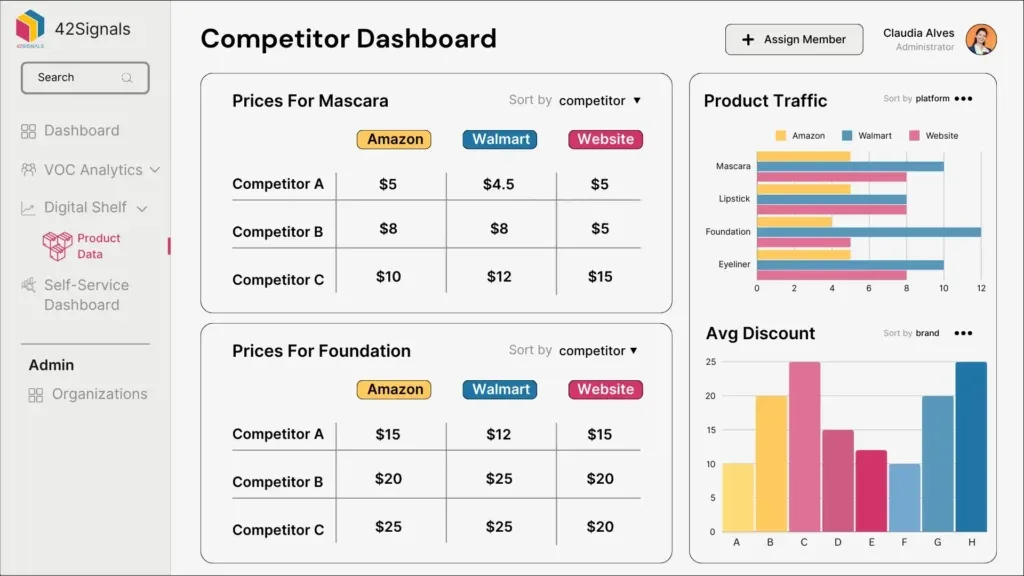
42Signals helps businesses in several ways, here are a few benefits of the platform –
- Visibility into key metrics: Instant access to crucial information such as competitive advantages, customer reviews, star ratings, product availability, category benchmarks, and price violations in the marketplace, leading to informed decision-making.
- Customizable analytics: Personalized data point selection according to individual organizational structures and objectives, moving away from a one-size-fits-all approach and generating targeted insights that drive action.
- Fair pricing across marketplaces: Ensuring consistent and equitable pricing throughout various platforms, eliminating discrepancies, and promoting trust among consumers.
- Competitive strategic planning: Harnessing competitor data to facilitate effective decision-making, minimize missed opportunities, and positively influence revenue generation.
- VoC analytics for competitive advantage: Using Voice of Customer (VoC) analytics to gain a deep understanding of customers’ preferences, desires, and behaviors, ultimately improving products, services, and securing a competitive edge within the industry.
- Enhancing customer satisfaction: Identifying improvement areas based on gathered customer feedback, thereby increasing customer satisfaction and strengthening loyalty.
- Cost savings and time efficiency: Reducing resource waste and minimizing manual tasks through automation, allowing users to focus on core business functions.
Curious to know more? Schedule a demo today.
Frequently Asked Questions
How do you monitor pricing? Monitoring pricing involves systematically tracking and analyzing the prices of your products and those of your competitors to make informed business decisions. Methods include:
- Manual Tracking: Regularly visiting competitor websites and recording prices in spreadsheets. This method is labor-intensive and prone to errors.
- Automated Price Monitoring Tools: Utilizing software solutions that automatically track and report competitor pricing. These tools provide real-time data, historical price trends, and alerts for price changes.
Why is it important for marketers to monitor the competition’s prices? Monitoring competitors’ prices is crucial for marketers to:
- Stay Competitive: Ensures pricing strategies are aligned with market standards, preventing loss of customers to lower-priced alternatives.
- Identify Market Trends: Helps detect pricing trends and seasonal fluctuations, allowing for proactive adjustments.
- Enhance Profit Margins: Enables optimization of pricing to balance competitiveness with profitability.
- Inform Marketing Strategies: Provides insights into competitors’ promotions and discounts, aiding in the development of counter-strategies.
- Maintain Brand Image: Ensures pricing reflects the brand’s positioning in the market, whether as a premium or budget option.
Which tool is best for competitor analysis?
When it comes to competitor analysis, 42Signals stands out as a top choice, especially for e-commerce businesses seeking comprehensive insights. This AI-powered platform offers a suite of features designed to help brands stay ahead in a competitive market:
- Competitor Tracking: Monitor competitors’ product offerings, pricing strategies, and promotional activities in real time.
- Digital Shelf Analytics: Gain insights into product visibility and positioning across various online platforms.
- Customer Sentiment Analysis: Analyze customer feedback to understand market perceptions and identify areas for improvement.
Why should a marketer be aware of competitors’ prices?
Understanding competitors’ pricing is crucial for marketers for several reasons:
- Competitive Positioning: Knowing where your pricing stands relative to competitors helps in positioning your products effectively in the market.
- Profit Margin Optimization: Awareness of competitors’ prices enables you to set prices that maximize profits while remaining attractive to customers.
- Market Trend Identification: Monitoring pricing trends can reveal shifts in consumer demand and emerging market opportunities.
- Customer Perception: Pricing influences how customers perceive your brand; staying competitive ensures you meet their expectations
